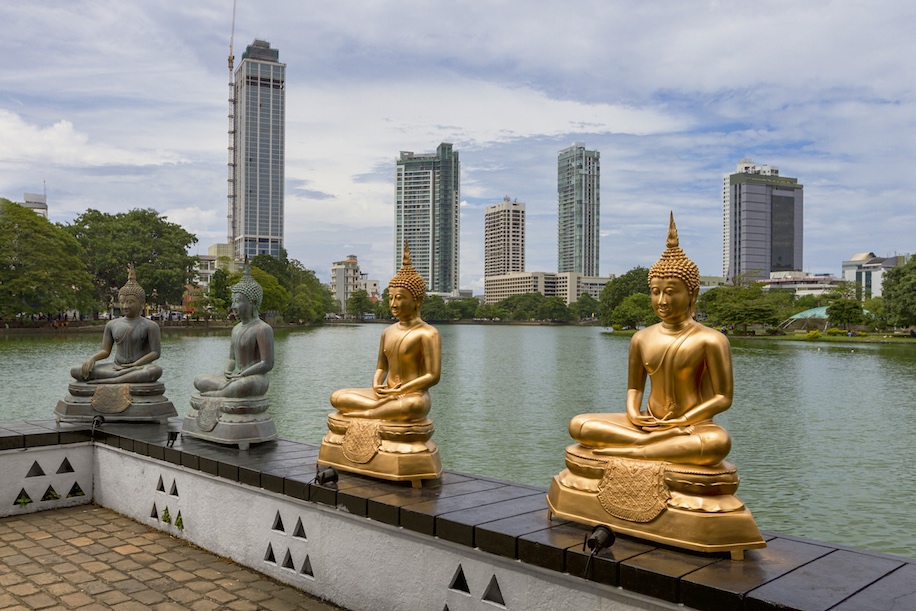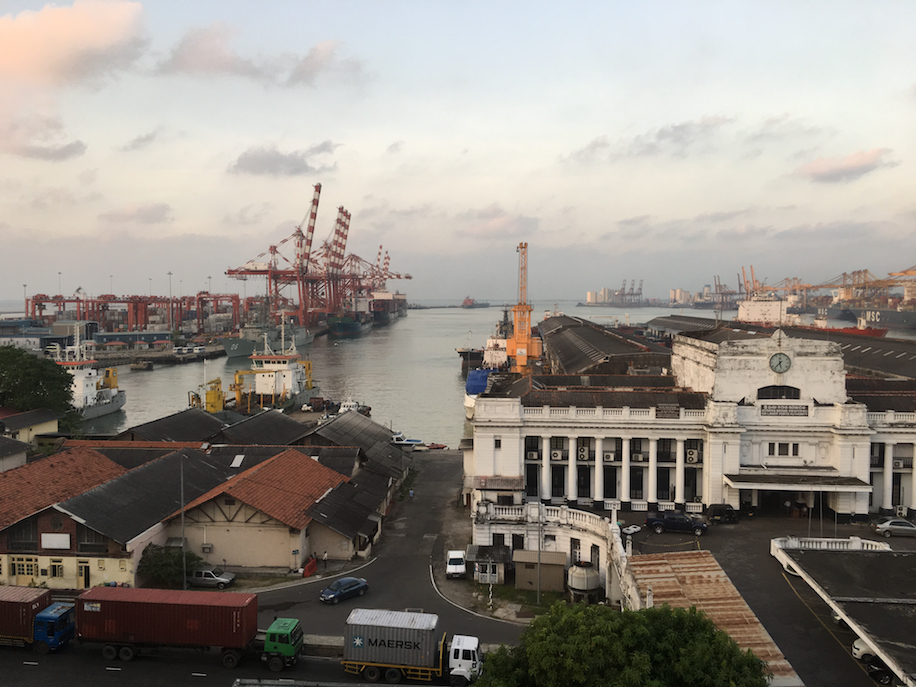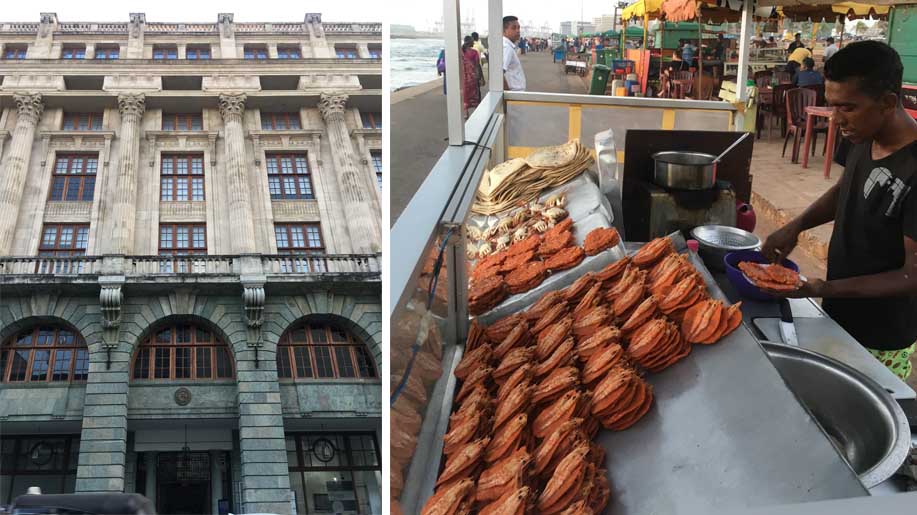
Colombo’s tourism propels its economy ahead, reports Akanksha Maker.
Colombo acquired the status of being Sri Lanka’s capital back in 1815, when the country was ceded to the British Empire. This was retained when it gained independence in 1948. In 1978, administrative functions were moved to Sri Jayawardenepura Kotte (Colombo’s satellite city), due to which it is known as the country’s “official capital”. However, Colombo is still designated as the commercial capital of Sri Lanka.
There are two operators that have daily direct flights to Colombo from Mumbai (where I flew out of) — Jet Airways and SriLankan Airlines. I chose the former’s overnight flight that arrived in the wee hours of the morning. Dawn hadn’t even cracked yet when we left the airport at 4:45am. Early risers and fitness enthusiasts jogged, walked or ran on the streets, while large groups of children participated in boot camps at the promenade of Galle Face Green, the ocean-side urban park. It stretches for 500 metres along the coast of the Indian Ocean.
I was in the city for the opening of Shangri-La Colombo, reviewed for our February issue and accessible on businesstraveller.com/tried-and-tested-category/hotels. On November 17, the hotel officially opened to the public with a grand ceremony that encompassed Chinese and Sri Lankan traditions such as “dotting of the eye” of the dragon, ceremonial lion dances and lighting of lamps. The opening was attended by more than 500 guests and diplomatic bigwigs including Maithripala Sirisena, the President of the Democratic Socialist Republic of Sri Lanka and Ranil Wickremesinghe, Prime Minister of Sri Lanka.
During the next few days of my stay at the property, I got a chance to explore the capital city in depth before Shangri-La Colombo’s official inauguration. Suggestions on what to see in Colombo are towards the end of this article.

POSITIONING
Tourism — leisure and business — has always been important for the economy of Colombo. The city has been amongst the most rapidly developing ones in the Asia Pacific region. Owing largely to this, Sri Lanka maintains an average GDP of six per cent this year and forecasts an average GDP of 6.2 per cent until 2020. The service sector contributes to almost 60 per cent of the economy — this includes financial services, telecommunication and lastly tourism. As per the Sri Lanka Tourism Development Authority (SLTDA), between 2010 and 2016, tourism became the third largest contributor to its Foreign Exchange Earnings (FEE) from being the fifth largest one.
These numbers don’t seem surprising since Sri Lanka’s vivid landscapes and strong traditions are enough to welcome all kinds of travellers. Its azure beaches, antiquated forts, lip-smacking cuisine, cultured citizens and warm hospitality draw visitors from the world over. The FIT (frequent independent traveller) especially, finds Sri Lanka appealing thanks to its modest size and affordability.
According to Tim Wright, vice president and general manager at Shangri-La Colombo, the city has the potential to become one of the most preferred destinations within the region. “Colombo offers good value for money for travellers on a budget. Heritage buildings, good infrastructure and clean roads are added advantages. All the modern facilities that tourists expect from a big city are in place. At the same time, Colombo has managed to retain its old-world charm with its colonial structures and churches. And of course, its people are well spoken and well read, and hospitality is warm,” he said.
Wright further stressed on the island country’s untouched beauty being its unique selling point. “Most of the other countries in the region saw drastic development and lost out on their quaintness — an aspect that Sri Lanka has managed to preserve in spite of its advancements.”
CONNECTIVITY
Over time, the government has begun to embrace and realise the potential of Sri Lanka’s versatile offerings. Not only has it robustly been boosting infrastructure and connectivity, it has also made it easier for travellers to visit the island country, thanks to the convenient Electronic Travel Authorisation (ETA) process. I noticed this when I visited, as all I had to do was complete the visa application process from eta.gov.lk, after which I received an ETA acknowledgement that I presented to the immigration officers in both the countries at the time of travel.
All this is teamed up with excellent connectivity to Colombo from the rest of the globe, as well as within Sri Lanka, which makes the island easily accessible to the world. Since Sri Lanka is a relatively small island with an area of 65,610 sqm and a population of around 21 million (Mumbai’s population is about 18 million), tourists more often than not fly into Colombo to begin their jaunt across the country. (The second international airport is near Hambantota to the south and is served by fewer airlines.) Rented cars, the bus or the train are common modes of transport to explore Sri Lanka from Colombo.
While booking my ticket to Colombo, I happened to read up on the improved connections between India and Sri Lanka. Airlines plying the region have actively been adding flights between Indian destinations and the commercial capital of Sri Lanka. Last year, SriLankan started non-stop Hyderabad-Colombo and Coimbatore-Colombo flights. A direct flight between Varanasi and Colombo was flagged off by Air India in 2017. India’s low-cost airline, IndiGo began operations between Chennai and Bengaluru, and Colombo this January.
India’s proximity to Sri Lanka and similarities in their cultural fabrics (Tamilians constitute about 11 per cent of the population) have continued to attract more Indian travellers over the years. In fact, India is the number one source market for international tourists to Sri Lanka — a status the nation has held for the past ten years. The south of India is better connected to Colombo due to its proximity, enabling south Indians to visit for a quick weekend getaway as they could reach Colombo sooner than they could reach north India.

HOSPITALITY
Better connectivity and an increase in tourism figures have attracted a number of international hospitality companies to invest here. Apart from Shangri-La Hotels and Resorts, another heavyweight that’s soon making its way to Sri Lanka is India’s ITC Hotels. It plans to debut its first international venture in Colombo, right beside Shangri-La Colombo, a property that was under development when I was there. Being implemented by WelcomHotels Lanka, a wholly owned subsidiary of ITC Hotels, ITC Colombo One is scheduled to open in 2021.This 300-key property will be a mixed-use project with both hotel and residential offerings. Speaking at the launch of the project back in 2014, Y C Deveshwar, chairman of ITC said, “India and Sri Lanka have shared a common heritage in the sub-continent and have generations of rich socio-cultural ties.”
Personally, one of the first references ingrained in my mind of Sri Lanka are from the Indian epic of Ramayana, which talks about Ravan’s kingdom of Lanka and all its glories — the first mention linking the two countries. Deveshwar said, “ITC Colombo One will build on this heritage and strengthen our relations even further. I am sure that this landmark hotel will add a jewel to the crown of Sri Lanka’s hospitality sector.” An investment of US$300 million has been made by the homegrown hotel company in Sri Lanka, hinting at the importance of this market for Indian hospitality companies.
There are several other players looking to add or update their inventories here. In June last year, Sri Lankan Prime Minister Ranil Wickremesinghe put together a 13-member tourism task force that was chaired by the likes of (then) Tourism Ministry Secretary Janaka Sugathadasa and (then) Sri Lanka Tourism Chairman Paddy Withana. The team drafted a report that revealed some interesting findings and numbers with regard to the hospitality industry here. Currently there are about 5,367 rooms in the range of three- to five-star hotel categories. By 2021, Colombo will offer an additional 4,135 rooms in the four- to five-star categories. As per the report, new rooms are coming from Cinnamon Hotels and Resorts (800), Hyatt Hotels (559), Marina Bay Sands (270), Next Hotels and Resorts (200), Radisson Hotels (300), Ritz Carlton (200), Sheraton Hotels and Resorts (306) and Four Seasons Hotels and Resorts (350).
While the added inventory will further aid tourism, it will also boost Colombo’s position in corporate travel. The business of events is already an important contributor to tourism; according to JLL Research, a professional services firm, around 65 per cent of Colombo’s hotel demand comes from MICE and business travel. Shangri-La Colombo has provided the city with the largest pillar-less ballroom in all of Sri Lanka, and as per Wright, this is an arena the hotel would like to focus on. He says the property is already suited to MICE, “thanks to its large-scale meeting facilities and a 500-room inventory”. Colombo’s entire potential as an ideal MICE city is still untapped — an aspect that will progress with more function spaces and hotel rooms as new hotels open up here.
WHAT TO SEE
Wake up early in the morning and take a stroll on the promenade of Galle Face Green as you soak in the rising sun and view of the Indian Ocean. If you visit in the evening, you’ll observe families and locals taking some time out from their schedules to relax. There is an array of food stalls selling seafood such as fried shrimp and authentic Sri Lankan items such as kottu roti, a dish made from roti and vegetables, egg and/or meat, and spices. Those interested in Colombo’s diverse culture must visit the Buddhist Gangaramya Temple (gangaramaya.com) that exhibits an eclectic mix of Sri Lankan, Thai, Indian, and Chinese architecture. A museum, a library, a residential hall, a three-storeyed Pirivena (a monastic college), educational halls and an alms hall are part of the temple premises. Colombo’s colonial facet is best enjoyed walking in its lanes and by-lanes by the Dutch Hospital Shopping Precinct that’s considered to be one of the oldest imperial structures of the city. Originally built as a hospital by the Dutch, the building was transformed into a shopping and dining precinct in 2011 with its historic architecture still in place. Renowned curator, researcher, photographer, wildlife enthusiast, and brainchild of “Colombo City Walks” (colombocitywalks.blogspot.in), Mark Forbes organises an interesting walking tour that begins at this point. Over the next three hours, you walk through the streets, alleyways, passageways, shops, hotels, churches and buildings of Fort (the central business district of Colombo in Sri Lanka) and the Pettah neighbourhood. En route the tour, you will see treasures of Colombo’s imperial heritage such as the oldest clock tower in Asia and the original colonial era emblem of the HSBC bank. Those with more time on hand could visit Sri Lanka’s iconic luxury Ayurveda Spa Ceylon (spaceylon.com) for a treatment or to take back its traditional and organic well-being products.

WHERE TO STAY
Shangri-La Colombo
The 541-key Shangri-La Colombo overlooks Colombo’s Galle Face Green promenade. Deluxe Ocean View rooms, Deluxe Lake View rooms, Premier Balcony rooms and Premier Ocean View rooms, Executive suites, Speciality suites and the Shangri-La suite are its accommodation types. Horizon Club Lake View and Horizon Club Ocean View rooms offer access to the Horizon Club Lounge. There are three restaurants and two bars on the property including Shangri-La’s signature Chinese restaurant — Shang Palace, and its Sri Lankan tapas-style plates restaurant — Kaema Sutra. There is a 24-hour fitness centre, a swimming pool, vitality pools, steam rooms and CHI, The Spa. Meeting spaces sprawl across 3,500 sqm. shangri-la.com
Cinnamon Lakeside Colombo
The 346-key Cinnamon Lakeside Colombo is situated by the Beira Lake, minutes away from Galle Face Green. Superior, Premier and Executive rooms, Cilantro suites and the Presidential suite are its accommodation types. The hotel has nine F&B outlets including its all-day dining restaurant — The Dining Room, 7° North (Mediterranean cuisine), Long Feng (Chinese cuisine) and Royal Thai (Thai cuisine). Azmaara Spa, Power Drome fitness centre and an outdoor swimming pool are its leisure facilities. The property houses two ballrooms, three conference venues, three boardroom suites and an exclusive floating venue on the Beira Lake. Cinnamon Lakeside Colombo curates a number of experiences for its guests including nature walks and river cruises. cinnamonhotels.com
Taj Samudra
The 300-key Taj Samudra is situated on Galle Face Road and sprawls across 11 acres of manicured gardens. It offers Deluxe rooms, Luxury rooms, Taj Club rooms, Executive suites, Deluxe suites, Luxury suites, Grand Luxury suites and the Tata suite as accommodation categories. There are six F&B outlets on the property including Navratna (Indian cuisine), Yumi (Japanese cuisine), Golden Dragon (Chinese cuisine) and Pebbles (patisserie). Taj Samudra offers a choice of seven meeting rooms that can accommodate up to 500 people including a 140-year-old Heritage block with four halls depicting colonial architecture. The property has an outdoor swimming pool and Taj Hotels Resorts Safaris’ signature Jiva Spa. tajhotels.com












